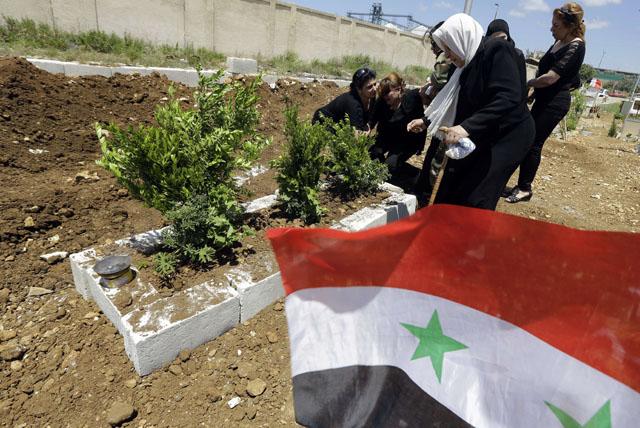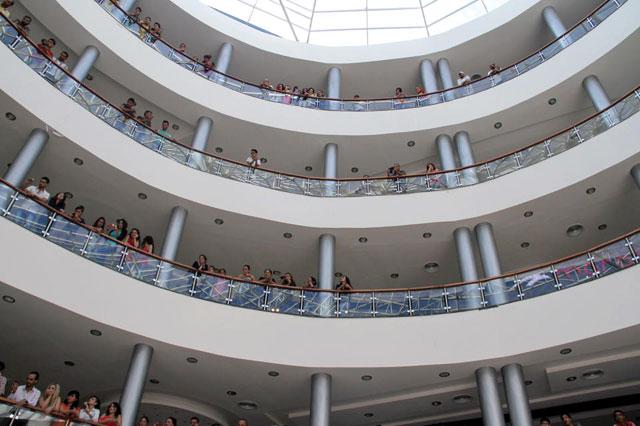You are here
Tartus in Syria, a supplier of ‘martyrs’ for Assad
By AFP - May 20,2014 - Last updated at May 20,2014

TARTUS, Syria — Tartus has itself largely escaped the conflict in Syria, but posters of its sons killed fighting for the regime elsewhere in the country line the western city’s main road.
A wall in the central bus station is a tapestry of pictures of the dead, most of them young, posing in fatigues with Kalashnikovs.
There are also photographs of President Bashar Assad, and his father and predecessor Hafez Assad, as well as the Syrian flag and sometimes images of Jesus Christ.
One shows a young man posing like Rambo, a cartridge belt around his bare torso as he cradles a machinegun.
Many shops in the city of 90,000 display large posters proclaiming the “Glory of the Unknown Soldier”. In Martyrs Square, banners list those who fell battling “terrorism”, the regime term for Assad’s opponents.
More than 162,000 people have been killed since Syria’s conflict began in March 2011 with a harsh government crackdown on anti-Assad protests.
While coastal Tartus has remained relatively insulated from actual fighting, its residents have swelled the ranks of the army and pro-regime militia, the National Defence Force (NDF).
“Tartus has been called the capital of martyrs because it’s the province with the highest proportional number of casualties in the army and the NDF — 4,200 killed, 2,000 wounded and 2,000 missing,” Tartus governor Nizar Mussa said.
“There isn’t a district, a village that doesn’t have its share of victims,” he told AFP.
The director of the Syrian Observatory for Human Rights, a Britain-based monitor tracking the war’s casualties, puts the number even higher, saying around half of the 60,000 regime fighters killed come from Tartus.
They have died in clashes countrywide.
“Tartus’s borders are limited not by those of the province, but of Syria as a whole,” said Ahmed Khaddur Abu Hadi after burying his brother Hassan, 40, an NDF fighter.
He was killed in Kasab near the border with Turkey.
“People from Tartus are fighting in Latakia and Aleppo provinces or in Qalamun [near Damascus]. They go everywhere and fall as martyrs in defence of the nation,” he added, his sister-in-law weeping beside him.
Mussa says that more than a dozen ambulances go daily to Latakia’s Bassel Al Assad airport, named after the president’s older brother who died in a 1994 car crash, to collect the bodies.
A ‘human reservoir’
Observatory director Abdel Rahman calls Syria’s coastal area, where most residents share Assad’s Alawite faith, “the human reservoir for the regime”.
“They have taken advantage of the confessional discourse of certain Islamist groups who talk about fighting the Nusayris [a derogatory term for Alawites] to promote Alawite recruitment,” he said.
“They fight to the end, convinced that it’s either Bashar or the end of the Alawites.”
In Tartus cemetery, Syrian flags flutter above dozens of graves, many bearing photos of the deceased. Some are marked only with numbers because the victims are unidentified.
The governor says residents sign up to fight for economic and ideological reasons.
“The region is poor. There’s not much agricultural land, no factories and few service sector jobs, so many people join the army,” he said.
But, he added: “We mustn’t forget that this is the only province where illiteracy has been eradicated.
“People who know how to read and write have understood the scale of the conspiracy against their country, and want to stop it.”
In September 2013, the government created a “martyrs’ affairs” office in each province to help relatives of those killed.
“Every day around 100 widows and orphans come to me and I try to help them with what the state has allocated,” said Mona Ibrahim who heads the Tartus bureau.
Her own husband was killed in 2011 in Baba Amr in Homs.
Fabrice Balanche, a French geographer who specialises in Syria, says Tartus is 80 per cent Alawite, 10 per cent Sunni, 9 per cent Christian and 1 per cent Ismaili.
Of the Alawites, 90 per cent are employed by the state, in the bureaucracy or the army.
“When the crisis began, the [pro-regime] ‘shabiha’ militias were created and then the National Defence Force to support the army,” Balanche said.
“Then the reservists were called up. All the men between 20 and 40 in Alawite areas are serving under the flag,” he added.
“They respond to the call because defending the regime means defending their community.”
Related Articles
Even for some of the Syrian regime’s staunchest supporters, this month’s launch of a glitzy new shopping mall and tourism projects seems to have been a step too far.
BEIRUT — Weakened by years of war, Syria’s government appears ready for the country’s de facto partition, defending strategically important
Fighting raged Saturday between rebels and loyalist forces in Syria’s northern Latakia province, a day after 34 people were killed as Islamists sought to seize a border crossing into Turkey, an NGO said.


















